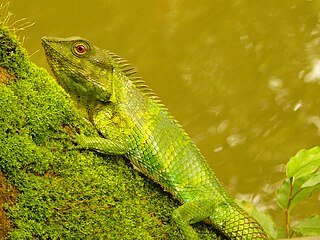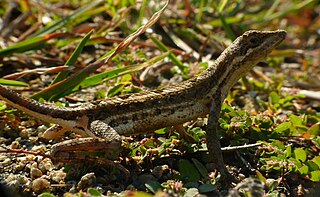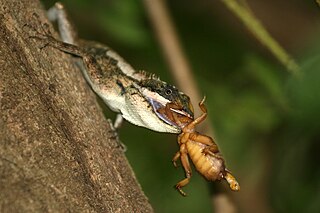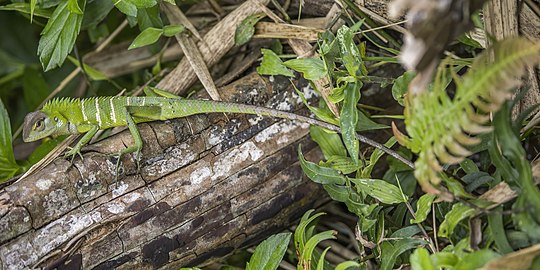
Ceratophora is a genus of agamid lizards found in Sri Lanka. The male has a horn on its snout.

Lyriocephalus is a genus of lizard within the agamid family, with the sole species Lyriocephalus scutatus. It is the largest agamid endemic to Sri Lanka and lives in dense wet zone forests. It is also called the hump-nosed lizard, hump snout lizard or the lyreshead lizard. In Sinhalese language, it is known as "Kandukara Bodilima – කදුකර බෝදිලිමා."

Salea is a genus of arboreal, slow-moving, diurnal, insectivorous, egg-laying agamid lizards endemic to the Western Ghats of South India. It has two species, each inhabiting very high mountainous tracts of the Western Ghats in the Shola forest ecosystems.

Bronchocela jubata, commonly known as the maned forest lizard, is a species of agamid lizard found mainly in Indonesia on the islands of Singkep, Java, Bali, Sulawesi, Karakelang, Salibabu; Nias Island, Singkap Island, Borneo (Kalimantan) also in Thailand, Cambodia and Philippines. Although in the past it was thought the species may be found in India, either on the mainland or in the Nicobars, this is not the case according to herpetologist Das. It is also known by the common name of "bloodsucker", although this is a misnomer.

Monilesaurus ellioti, or Elliot's forest lizard, is a species of arboreal, diurnal, lizard in the family Agamidae, endemic to the Western Ghats, India.

Calotes jerdoni, commonly known as the Indo-Chinese forest lizard or Jerdon's forest lizard, is a species of lizard in the family Agamidae. The species is endemic to China and South Asia.

Calotes mystaceus, the Indo-Chinese forest lizard or blue crested lizard, is an agamid lizard found in China, South Asia and Southeast Asia.

Calotes nemoricola, the Nilgiri forest lizard, is an agamid lizard found in the Western Ghats of India.

The oriental garden lizard, eastern garden lizard, Indian garden lizard, common garden lizard, bloodsucker, or changeable lizard is an agamid lizard found widely distributed in indo-Malaya. It has also been introduced in many other parts of the world.

The Caucasian agama is a species of agamid lizard found in the Caucasus, E/S Georgia, Armenia, Azerbaijan, Turkmenistan, Tajikistan, Dagestan (Russia), E Turkey, Iraq, N Iran, Afghanistan, NW Pakistan, and parts of Kashmir.

The Himalayan agama is an agamid lizard found in Central Asia and South Asia.

Laudakia tuberculata is a species of agamid lizard found in northern Pakistan, northern India, Nepal, eastern Afghanistan, and western China.

The peninsular rock agama or South Indian rock agama is a common species of agama found on rocky hills in south India. An allied species, Psammophilus blanfordanus, is found in the Eastern Ghats, but north of the range of this species.

The Pondichéry fan-throated lizard is a species of agamid lizard found in eastern peninsular India. It was earlier thought to be widespread but studies in 2016 resulted in the splitting of the group into several species placed in two genera. The genus Sitana has an enlarged projecting scale on the posterior side of the hind thigh which is absent in the sister genus Sarada.
Microauris is a monotypic genus of agamid lizard. Its only species is Microauris aurantolabium, also known as the small-eared dragon or orange-lipped forest lizard, found in the forests of the southern Western Ghats and is currently known from the Kalakkad Mundanthurai Tiger Reserve. The species was formerly included in Pseudocalotes andamanensis of the Andaman Islands, but recognized as distinct in 2008. It was also classified under Calotes until 2018, where it was transferred to its own genus, Microauris, on the basis of its divergence from Calotes.

Calotes ceylonensis, commonly known as the painted-lipped lizard or the Ceylon bloodsucker, is a species of lizard in the family Agamidae. It is one of four Calotes species endemic to Sri Lanka.

The whistling lizard, or Sri Lanka agama, Calotes liolepis is a species of lizard in the family Agamidae. It is one of four Calotes species endemic to Sri Lanka.

Calotes nigrilabris, the black-cheek lizard, is an agamid species endemic to Sri Lanka. It can be distinguished easily from painted-lipped lizard by having black bar on mouth rather than white or orange bar.
Calotes manamendrai is an agamid lizard endemic to Sri Lanka. Locally known as මනමේන්ද්ර-ආරච්චිගේ උරුවන් කටුස්සා.

The Sulawesi black sailfin lizard is a species of agamid native to Indonesia. It is the second largest species of sailfin dragon, with only the Sulawesi giant sailfin dragon being larger., exceeding 1000 mm in total length, possibly 1200 mm. Head, neck, gular region and shoulder completely black; a row of enlarged flat, sometimes conical scales on either side of the neck; nuchal and dorsal crests continuous; a group of dirty white enlarged flat scales on the anterior part of the dorsum; few (<10) additional enlarged scales approximately at midbody and before the hindlimbs. Dorsal colouration typically yellowish, sometimes dark orange, interspersed with black spots; ventrally beige, limbs black with a few yellow spots; scales under fourth and fifth toes broad with several keels from near the base of the toe; tail black, sail black or dark violet with black stripes.























